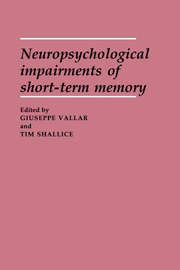Book contents
- Frontmatter
- Contents
- List of contributors
- Acknowledgments
- General introduction
- I THE FUNCTIONAL ARCHITECTURE OF AUDITORY–VERBAL (PHONOLOGICAL) SHORT-TERM MEMORY AND ITS NEURAL CORRELATES
- 1 The impairment of auditory–verbal short-term storage
- 2 The development of the concept of working memory: implications and contributions of neuropsychology
- 3 Multiple phonological representations and verbal short-term memory
- 4 Electrophysiological measures of short-term memory
- II PHONOLOGICAL SHORT-TERM MEMORY AND OTHER LEVELS OF INFORMATION PROCESSING: STUDIES IN BRAIN-DAMAGED PATIENTS WITH DEFECTIVE PHONOLOGICAL MEMORY
- III SHORT-TERM MEMORY STUDIES IN DIFFERENT POPULATIONS (CHILDREN, ELDERLY, AMNESICS) AND OF DIFFERENT SHORT-TERM MEMORY SYSTEMS
- IV PHONOLOGICAL SHORT-TERM MEMORY AND SENTENCE COMPREHENSION
- Name index
- Subject index
2 - The development of the concept of working memory: implications and contributions of neuropsychology
Published online by Cambridge University Press: 11 May 2010
- Frontmatter
- Contents
- List of contributors
- Acknowledgments
- General introduction
- I THE FUNCTIONAL ARCHITECTURE OF AUDITORY–VERBAL (PHONOLOGICAL) SHORT-TERM MEMORY AND ITS NEURAL CORRELATES
- 1 The impairment of auditory–verbal short-term storage
- 2 The development of the concept of working memory: implications and contributions of neuropsychology
- 3 Multiple phonological representations and verbal short-term memory
- 4 Electrophysiological measures of short-term memory
- II PHONOLOGICAL SHORT-TERM MEMORY AND OTHER LEVELS OF INFORMATION PROCESSING: STUDIES IN BRAIN-DAMAGED PATIENTS WITH DEFECTIVE PHONOLOGICAL MEMORY
- III SHORT-TERM MEMORY STUDIES IN DIFFERENT POPULATIONS (CHILDREN, ELDERLY, AMNESICS) AND OF DIFFERENT SHORT-TERM MEMORY SYSTEMS
- IV PHONOLOGICAL SHORT-TERM MEMORY AND SENTENCE COMPREHENSION
- Name index
- Subject index
Summary
Models of memory
Research on short-term memory (STM) provides a particularly good example of the fruitful interaction of neuropsychology with techniques and theories developed in the study of normal memory. Since the majority of contributions to this volume will be concerned with data from patients, it was suggested that an overview of the field from the viewpoint of normal memory might be appropriate. This will be attempted, followed by a more detailed discussion of some of the issues that remain unresolved, and where further neuropsychological evidence might be particularly revealing.
How many kinds of memory?
In his classic book The Organization of Behavior, Hebb proposed that memory comprised two separable systems, one based on temporary reverberating electrical activity, the other representing a more long-term change based on neural growth. Such a dichotomy became more widely supported in the late 1950s with the development of a range of techniques that appeared to indicate some kind of temporary storage where forgetting was rapid and was assumed to be based on trace decay (Broadbent, 1958; Brown, 1958; Peterson and Peterson, 1959).
In the early 1960s, Melton (1963) argued that the assumption of a dichotomy was unnecessary and unparsimonious. He maintained that the phenomena attributed to short-term memory could better be conceptualized as reflecting the functioning of normal long-term memory (LTM) under conditions of brief presentation and minimal learning, with forgetting being based on the principles of interference theory. During the mid-1960s this led to a flurry of activity concerned with the question of whether it was necessary to assume separate long- and short-term memory systems. Evidence came from a number of sources, but the following three were perhaps the most prominent.
- Type
- Chapter
- Information
- Neuropsychological Impairments of Short-Term Memory , pp. 54 - 73Publisher: Cambridge University PressPrint publication year: 1990
- 33
- Cited by

